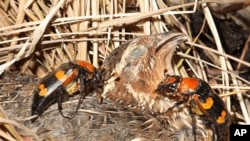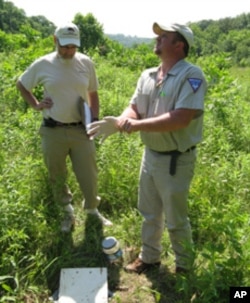The American burying beetle is one of nature's most efficient scavengers, breaking down dead animals and recycling their nutrients back into the environment.
A hundred years ago, the insect was common across North America. Today, it's down to a handful of small populations, inhabiting less than ten percent of the species' historic range.
Now, a group of dedicated supporters is working to restore this critically endangered species.
Natural recyclers
On a dark summer night, a couple finds a dead body in a field. They remove the bones, and bury it. Later, they will use the remains to feed their young.
That's business as usual for Nicrophorus americanus, the American burying beetle.
Bob Merz of the St. Louis Zoo in Missouri is one of the beetle's biggest fans. According to Merz, these thumb-sized, black-red-and-orange insects can fly almost five kilometers in a single night, in search of small dead animals or birds. When they find one, they fight over it. After the winning male and female claim the body, they move it to a safer place.
"And how they move it is they will lay on their backs underneath the carcass and use their legs to push it kind of over them," Merz says. "And so they create this little conveyor belt basically of 12 little beetle legs that kind of move the carcass to a site."
There, the beetles dig a hole, sometimes as much as a meter deep under the body, concealing it in the subterranean chamber. They remove the animal's bones, hair, feathers, or fur, and spray the carcass with preservative secretions, forming a kind of gooey meatball.
Important to the ecosystem
Then the beetles mate. The female lays her eggs on or near the carcass, and in just two or three days, they hatch.
"This is where it gets kind of cool," says Merz. "The beetles will stay with their young and raise them."
When it's feeding time, the adults make a noise by rubbing their flight wings against their hard upper shell. "That noise then calls their larvae, which are these tiny white little puffy wormlike looking things," Merz explains. The larvae sit up and beg for food, something like baby birds. "And the parents will then tear off pieces of meat, and regurgitate them back, into the mouths of their young. And they are cute," laughs Merz. "For a beetle grub, they are cute, they really are."
And important to the ecosystem. Once they've matured into adults, the beetles will repeat the cycle, breaking down more carcasses to feed a new generation of young.
Declining species
No one knows for sure what caused the beetles' decline. Theories include pesticides, light pollution, a decrease in appropriately-sized prey, and the most likely culprit: habitat loss and fragmentation.
Merz and his team from the St. Louis Zoo have been looking for the beetle in Missouri since 2004. Every year, they set out pitfall traps: two-liter plastic buckets buried in the soil, with pieces of slightly rotten chicken for bait.
Dan Koch works on beetle recovery efforts for the zoo. He says the field surveys can be a pretty smelly business. "The maggots still get in there and lay eggs, and you'll have chicken that really is just a goo of maggots, it's not even chicken anymore by the time you pull up the traps."
They haven't found the American burying beetle in Missouri. But they have successfully raised more than 5,000 thousand of them at the zoo.
Reintroduction
Retired attorney Kay Thurman volunteers on the project, helping to feed the beetles. She says it's gratifying to be able to work hands-on with an endangered species.
"It isn't like I can go out and feed a cheetah, or save a cheetah," says Thurman. "But this is really an opportunity for a volunteer to get in here and work directly with individual animals that we're trying to propagate and preserve here at the zoo."
Some of those beetles have been released in the Midwestern state of Ohio, to try to re-establish a population there. Other captive-reared beetles have been reintroduced on the island of Nantucket, off the northeastern U.S. coast.
And now, the U.S. Fish and Wildlife Service is considering proposals to try to re-establish more populations in other areas - including in Missouri. Those reintroduction plans haven't been finalized yet.
In the meantime, Merz says he and his team will keep doing their part to bring the endangered beetle back.













